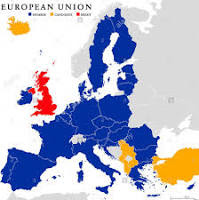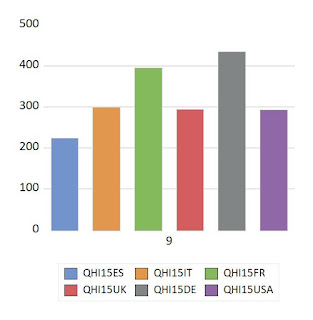Year 2023
Current External
Challenges to the Economic Expansion of Emerging Markets: An Analysis of
Chile, Colombia, Mexico, Turkey, Ghana and India for 2006-2021, Juan Carlos
MORENO-BRID, Lorenzo NALIN, Edgar PEREZ-MEDINA Abstract
How Does Intra-State Violence Affect Nations´Trade Flows? A Quantitative Assessment on South Bond market development as a source of financing infrastructure projects: A comparison of India, Russia and other countries, 2010-2020, Arnaud NZENGUET NZENGUET, Abssract
Selected books on World Development: Education, Freedom, Political Stability, Peace and Qualtity of Life: E-books on World Development for the periods 1960-2000 and 2001-2023, Maria-Carmen GUISAN, Abstract
Panel Data Analysis of the Human Capital Index and Income Inequality: A Panel of 203 Countries for the Period 1988-2018, Brandon PARSONS Abstract
Per Capita Income Convergence and Divergence of
Selected OECD Countries to and from the US: A
Reappraisal for the period 1900-2018, László
KÓNYA Abstract
Are shocks to electricity consumption permanent or
transitory? Evidence from a panel stationarity test with gradual structural
breaks for 25 OECD countries, Jamal
G. HUSEIN; S. Murat KARA Abstract
Year 2022
Income Inequality,
the World Values Survey, and the Interaction of Cultural Dimensions,
Edwards, J. A., Romero, A., Naanwaab, C. Abstract
Life
Satisfaction, Income, Security And Environment: An Interregional
Econometric Model of 372 Regions From Europe, America, Asia And Oceania
In Year 2016, Guisan, M.C. Abstract
Impact Of
Economic And Financial Openness On Domestic Inequality In Developing And
Emerging Countries: A Panel Data Study Of 11 Countries For 1980-2016, El
Bouhadi, A., Ouahid, D., Elkhider, A. Abstract
The Impact Of
Digital Financial Inclusion On Socio-Economic Development In Low-Income
Countries, Yakubi, Y.A.Y., Basuki, B.,
Purwono, R. Abstract
Economic Growth And Military Expenditure In Developing Countris During Covid-19 Pandemic, Susilo, A.K., Sari, D.W., Putra, I. N., Pratiwi, N.A. Abstract
Political Stability, Peace And Economic Development In 164 Countries, 2010-2020, Guisan, M.C. Abstract
Year 2021
Export Led Growth Via Intra-Regional Trading An Econometric Analysis Of ASEAN, EU, NAFTA, MERCOSUR and COMESA, Haxman, S., Omar, K., Halimb, A. Samsudin, M.S. Abstract
World Development For 1995-2020: Econometric Relationships Of Human Capital, Development, Quality Of Government And Life Satisfaction In 164 Countries, Guisan, M.C Abstract
Secular Stagnation and the Negative Interest Rate Conundrum: International analysis of the Period 2010-2019, Warburton, Christopher E.S. Abstract
|
Year |
Article |
|
2020 |
The Acquisition of Human Capital and Economic Growth: An
international survey, Warburton, C.E.S. Abstract Financial development-poverty reduction nexus in
BRICS: A panel data analysis approach, Tsaurai, K. Abstract National Wealth Structure of the Countries of the
World and Economic Development, 2000-2014, Guzev, M.M., Ledeneva, M.V.,
Polkovnikov, A.A. Abstract Saving-Investment-Current Accounts Dynamics,
Financial Crisis and Economic Growth: Some Empirical Results,
AMIRKHALKHALI,S., DAR, A. Abstract Determinants of inward foreign direct investment:
Comparison across different country groups, Das, M. Abstract Core-periphery relations in the international
mergers and acquisitions network, Galaso, P.,
Sanchez-Diez, A. Abstract Oil Price And Economic Growth Of Oil-Importing
Countries: A Review Of International Literature, Akinsola, M.O,
Odhiambo, N.M. Abstract CO2 Total Emissions in the World, 1970-2015:
Relationship with Economic Development and Population Growth; Guisan, M.C.,
Exposito |
|
2019 |
FDI, Growth and Level of Development: Analysis of 76
countries for the period 1980-2010, Grubaugh,
S.G. Abstract The Duration of Trade Agreement Negotiations:
Analysis of 80 cases for 1980-2011, Arroyo, L.,
Castillo-Ponce, Ramon, A. Abstract Trade Openness, Factor Productivity, and Economic
Growth: Recent Evidence from OECD Countries,
AmirKhalkhali, S.; Dar, A.Abstract Debt Relief and Good Governance: New Evidence of
Developing Countries for the period 1990-2013, Freytag, A., Schmied, J.Abstract |
|
2018 |
Positive Time Preference and Environmental
Degradation: The effects of population growth and economic activity on
intergenerational equity, Christopher E.S. Warburton Abstract Determinants of the percentage of savings in
emerging markets: A panel data analysis approach, 1995-2015, K.
Tsaurai. Abstract Public Debt
Service And Economic Growth: A Survey Of International Literature, SAUNGWEME,
T., ODHIAMBO, N.M. Abstract Drivers Of
Growth In Fast Emerging Economies: A Dynamic Instrumental Quantile Approach
To Real Output And Its Rates Of Growth In BRICS And MINT Countries, 2001-2011,
Asongu, S., Odhiambo, N.Abstract Public
Consumption and Government Expenditure in 6 OECD Countries and Their Effect
IN Macroeconometric Models of Disequilibrium, 1970-2016, Guisan,
M.C. Abstract |
|
2017 |
Fiscal Policy, Total Factor Productivity
and Economic Growth in Advanced Economies, Dar, A.,
AmirKhalkhali, S. Abstract Key Determinants of Civil Liberty: a
Spatial Analysis of 175 Countries in the year 2010, Chasco, C.,
Lacalle-Calderon, M. , Alfonso-Gil, J. Abstract Market
Efficiency, Sovereign Debt Restructuring And Credit Ratings In Developing
Countries, Robinson, C.J., Bangwayo-Skeete, F. Abstract Effect of FDI on
real per capita GDP Growth. A Rolling Window Panel Analysis of 60 countries,
1982-2011, Edwards, J.A., Naanwaab, C.B., Alfredo
A. Romero, A.A. Abstract |
|
2016 |
The
Bottom Twenty: An Analysis Of Income Inequality In High Income And Developing
Countries, 1990-2010, by Christopher E.S. WARBURTON Abstract Interaction
Between Capital Flows And Current Account: A Dynamic Panel Causality Analysis
Of 19 Emerging Market Economies For The Period 1980 To 2009, by A.Yasemin
YALTA & Bahar BAYRAKTAR-SAGLAM Abstract Public Debt,
Saving-Investment-Current Account Dynamics, and Capital Mobility in OECD
countries, 1999-2013, S.
AmirKhalkhali, A. Dar Abstract Financial
Development and Economic Growth in advanced and developing
economies over the period 1975–2009, Doumbia,
D. Abstract Aid-for-Trade
and Export Performance of Developing Countries, Ghimire, S.,
Mukherjee, D., Alvi, E. Abstract The
International Law and Economics of Coercive Diplomacy: Macroeconomic Effects
and Empirical Findings, C E.S.
Warburton Abstract |
|
Year |
Articles |
|
2015 |
Saving-investment
Dynamics and capital Mobility in the BRICS, Behera, S.R. Abstract Corruption centralization, investments, and
growth, Nuryyev, G., Hickson, C. Abstract Reciprocity
in bilateral trade flows: An empirical analysis for trade between Australia
and Latin American countries, Gonzslez,
G.H., Esposto, A.S., , Valentina N. Viego, V.N. Abstract |
|
2014 |
Time
Dynamics of Stabilization Theories and Responses to Debt and Financial
Crises: An Analysis of Mexico, Argentina, Nigeria and Ghana, 1960-2011, Warburton,
C.E.S. Abstract Absorptive
Capacity Compared: Evidence from Sectoral Data of OECD, Asian and Latin
American countries, Montinari, L., Rochlitz, M. Abstract The
Effect of Labor Composition Index on Economic Development: Analysis of 18
countries for the period 1990-2010, Ozerkek, Y. Abstract New Prospects of
Economic Growth in Context of
Underdevelopment Whirlpools Phenomena,Popkova,
E.G. Abstract On The Impact Of
Public Debt On Economic Growth In 23 Countries, 1996-2007, Dar,
A.A., Amirkhalkhali, S.A. Abstract
|
|
2013 |
History of the
Global Business Environment in the Polycyclic Conceptual Framework and
Estimation of Econometric Models of World Development 1950-2010, Kokodey,
T.A. Abstract Macro-Econometric Models of Supply and Demand:
Industry, Trade and Wages in 6 Countries, 1960-2012 , Guisan,
M.C. Abstract The EFA
Development Index and Per Capita GDP: A Quantile Regression Approach in A
Cross-Section of 123 Countries for Year 2007, Islam,
S. Abstract Is There
Feed-Back Between Economic Freedom and Economic Growth: A Comparative
Granger-Causality Test Based On Quartiles, Webster,
A.L. Abstract |
|
2012 |
A Cross-national Panel Study of Devaluations on
Disaggregated Export Sectors: A Case for Sector Specific Policies, Cantavella-Jordá,
M., Amin Gutierrez de Piñeres, S. Abstract ISI and New Industrial Conditions in Latin America
and Africa, Warburton, C.E.S. Abstract On Explaining
Inter-Country Differences in Economic Growth Rates of OECD countries for
1996-2008: Does Regulatory Quality Matter?,
AmirKhalkhali, S., Dar, A.A. Abstract Microfinance
Social Performance:A Global Empirical Study, Marr,
A., Awaworyi, S. Abstract Development Aid,
Corruption, and the Happiness of Nations: Analysis of 118 countries,
1996-2009, Arvin, M.B., Lew, B., Abstract Fiscal Deficits,
Current Deficits and Investment: A Panel Causality Framework of 20 OECD
countries, Miteza, I. Abstract Civil Liberties and Access to Water: Analysis of 140 countries,
Biser, J.J, Edwards, J.A. Abstract Crisis Exacerbated Fiscal Deficits and Possible
Impact on FDI Flows: An Empirical Analysis of Emerging Europe and India, Bose,
S., Jha, S. Abstract
|
|
2011 |
Technology Gap, Catching-up and Outward Orientation:
Analysis of 63 countries, Iyer, K. Abstract On the Impact of Openness and Regulatory Quality on Saving- Investment
Dynamics in Emerging Economies, Dar, A., Amirkhalkhali, S. Abstract Effects of Health Systems and Socioeconomic Factors
in Reducing Child Mortality in Developing Countries: Empirical Results from
System Generalised Method of Moments, Kamiya, Y. Abstract AEID.Vol. 11-1. January-June of 2011 Health Care
Efficiency Across Countries: A Stochastic Frontier Analysis, Ogloblin,
C. Abstract Financial Globalization and Inflation In Developing
Countries: A Reappraisal, Miles, W. Abstract |
Cancelo, M.T.
(2010)
|
The Relationship between CO2 and
Sulphur Emissions with Income: An Alternative Explanation to The
Environmental Kuznets Curve Hypothesis. Abstract
|
Gimenez, G.,
Sanau, J.
(2009)
|
Investment, Human Capital and Institutions: A Multi-equational Approach
for the Study of Economic Growth, 1985-2000. Abstract
|
Karras, G.
(2008)
|
Growth and Convergence, 1950-2003. What Can We Learn From the Solow
Model? Abstract
|
Bildirici, M.,
Sunal, S. (2006)
|
Economic
Determinants of Development in World Economy, 1920-2005. An
Analysis of 165 Countries.
|
Guisan, M.C.,
Neira, I.
(2006)
|
Direct and Indirect Effects of Human
Capital on World Development, 1960-2004. Abstract
|
Auhtors
|
Article
|
Bildirici, M., Orcan, M.,
Sunal, S., Aykaç, E. (2005)
|
Determinants of
Human Capital Theory, Growth and Brain Drain: An Econometric Analysis for 77
Countries. Abstract
|
Valadkhani, A. (2005)
|
Macroeconometric
Modelling: Approaches and Experiences in Development Countries. Abstract
|
Sobhee, S.K.,
Joysuree, V. (2004)
|
The Implications
of Openness for WAGNER’S Law. An International Comparison of 20
Countries, 1971-2000. Abstract
|
Konya, L. (2004)
|
Export-Led
Growth, Growth-Driven Export, Both or None? Granger Causality Analysis on OECD
Countries. Abstract
|
Cook, S. (2004)
|
On the Detection
of Business Cycles Asymmetry in 22 Countries, 1870-1994. Abstract
|
Guisan, M.C.,
Exposito, P. (2004)
|
2.- Comparative
Studies of OECD Countries: Econometric
Models and Evolution of Agrarian and non Agrarian Employment in OECD
Countries, 1950-2000, Abstract
|
Guisan, M.C.,
Arranz, M. (2003)
|
Econometric
Models of Private and Public Health Expenditure in OECD countries, 1970-96. Abstract
|
Karras, G. (2003)
|
Trade Openness and Economic Growth: Can We Estimate
the Precise Effect?. Abstract
|
Guisan, M.C., Cancelo, M.T.
(2002)
|
Econometric Models of Foreign Trade in OECD Countries. Abstract y article
|
Cancelo, M.T., Guisan, M.C.,
Frias, I. (2001)
|
Supply
and Demand on Manufacturing Output in OECD countries: Econometric Models and
Specification test Abstract y
article |
Guisan, M.C. (2001)
|
Causality
and Cointegration between Consumption and GDP in 25 OECD countries:
Limitations of Cointegration Approach. Abstract y
article |
Guisan, M.C.,
Aguayo, E.
Exposito, P. (2001)
|
Economic
growth and cycles: Cross-country models of Education, Industry and Fertility
and International Comparisons. Abstract y
article |
Guisan, M.C.,
Aguayo, E.,
Exposito, P. (2001)
|
Education and World
Development in 1900-1999:
A General View and
Challenges for the Near Future. Abstract
https://ideas.repec.org/a/eaa/aeinde/v1y2001i1_4.html
|
More information about AEID: Editorial Board and inclusion en selected journals Indexes: See Entry 41 of this Blog.











